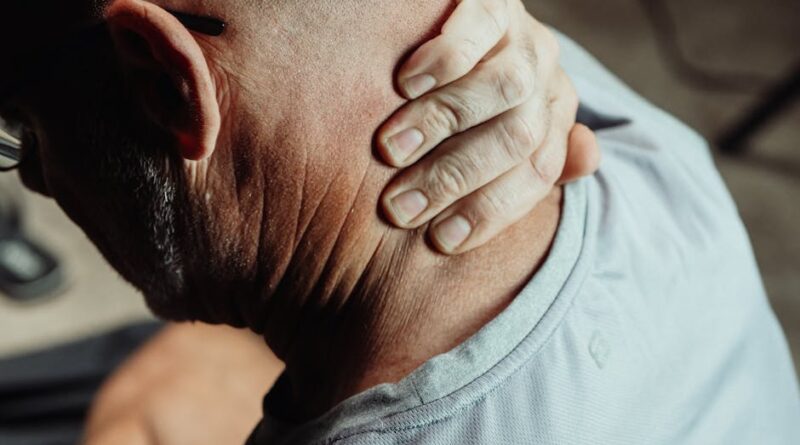Managing Chronic Pain Effectively: A Comprehensive Guide
Living with chronic pain can be a challenging and overwhelming experience. For many individuals, the persistent discomfort and disruptions caused by chronic pain can significantly impact their quality of life, making everyday tasks seem insurmountable. However, with the right strategies and approaches, it is possible to manage chronic pain effectively and regain control over your life. In this article, we will delve into the various aspects of managing chronic pain, exploring different techniques, treatments, and lifestyle changes that can help alleviate pain and improve overall well-being.
The Complexity of Chronic Pain

Chronic pain is a complex and multifaceted condition that can arise from a variety of underlying causes, such as injury, illness, or medical conditions. Unlike acute pain, which typically lasts for a short period of time and is often a signal of tissue damage or injury, chronic pain persists for weeks, months, or even years, long after the initial injury or condition has healed. This prolonged pain can have a profound impact on physical, emotional, and mental health, leading to decreased mobility, sleep disturbances, anxiety, depression, and reduced quality of life.
Managing chronic pain requires a comprehensive and holistic approach that addresses not only the physical symptoms but also the emotional and psychological aspects of pain. By combining medical treatments, lifestyle modifications, and self-care strategies, individuals can effectively manage their pain and improve their overall well-being.
Medical Treatments for Chronic Pain

Medical treatments for chronic pain aim to reduce pain intensity, improve function, and enhance quality of life. These treatments may include medications, physical therapy, injections, surgical procedures, and alternative therapies. Each treatment approach is tailored to the individual’s specific condition, symptoms, and preferences, with the goal of providing effective pain relief and improving overall function.
Medications are commonly used to manage chronic pain and may include over-the-counter pain relievers, prescription opioids, muscle relaxants, antidepressants, and anti-seizure medications. While medications can be effective in reducing pain, they may also come with potential side effects and risks, such as dependency, tolerance, and addiction. It is important for individuals to work closely with their healthcare providers to find the most appropriate medication regimen that balances pain relief with safety.
Physical therapy is another essential component of managing chronic pain, as it focuses on improving mobility, strength, and flexibility through targeted exercises, manual therapy, and other techniques. Physical therapists work with individuals to develop personalized treatment plans that address their specific needs and goals, helping them regain function and reduce pain.
In some cases, injections or surgical procedures may be recommended to alleviate chronic pain, particularly when conservative treatments have been unsuccessful. These interventions target specific areas of pain, such as joints, nerves, or muscles, and aim to reduce inflammation, improve function, and provide long-lasting pain relief. While invasive treatments carry risks and require careful consideration, they can be valuable options for individuals with severe or debilitating pain.
Alternative Therapies and Complementary Approaches

In addition to conventional medical treatments, many individuals with chronic pain turn to alternative therapies and complementary approaches to manage their symptoms and improve their well-being. These therapies may include acupuncture, massage therapy, chiropractic care, yoga, meditation, biofeedback, and herbal supplements, among others. While the evidence supporting the efficacy of these treatments varies, many individuals find relief and benefit from incorporating these modalities into their pain management plan.
Acupuncture, a traditional Chinese medicine practice that involves inserting thin needles into specific points on the body, is often used to alleviate pain, reduce inflammation, and promote relaxation. Research suggests that acupuncture may stimulate the release of endorphins, the body’s natural pain-relieving chemicals, and modulate the perception of pain in the brain, making it a popular choice for individuals with chronic pain.
Massage therapy is another widely used alternative therapy for chronic pain, as it can help relax tense muscles, improve circulation, and reduce stress. By targeting areas of pain and tension, massage therapists can alleviate discomfort and promote healing, leading to improved function and reduced pain intensity. Many individuals find massage therapy to be a valuable adjunct to their pain management regimen.
Lifestyle Modifications and Self-Care Strategies

While medical treatments and alternative therapies play a crucial role in managing chronic pain, lifestyle modifications and self-care strategies are equally important in achieving long-term pain relief and improving overall well-being. By adopting healthy habits, practicing self-care, and making positive lifestyle changes, individuals can reduce pain, enhance function, and regain control over their lives.
Exercise is a key component of managing chronic pain, as it can help strengthen muscles, improve flexibility, and reduce inflammation. Low-impact activities such as walking, swimming, yoga, and tai chi are beneficial for individuals with chronic pain, as they can improve physical function, reduce pain intensity, and enhance overall quality of life. It is important to start slowly, listen to your body, and work with a healthcare provider or physical therapist to develop a safe and effective exercise program.
Healthy eating habits are also essential for managing chronic pain, as a balanced diet rich in fruits, vegetables, whole grains, and lean proteins can help reduce inflammation, support immune function, and promote overall health. By fueling your body with nutritious foods, you can optimize your energy levels, improve your mood, and reduce pain symptoms. It is important to stay hydrated, limit processed foods, and avoid trigger foods that may exacerbate pain.
Stress management techniques, such as deep breathing, mindfulness meditation, progressive muscle relaxation, and guided imagery, can help individuals cope with the emotional and psychological aspects of chronic pain. By reducing stress and promoting relaxation, these techniques can lower pain levels, improve sleep quality, and enhance overall well-being. It is important to practice these techniques regularly and incorporate them into your daily routine for maximum benefit.
Support and Education for Chronic Pain Management
Living with chronic pain can be isolating and overwhelming, but with the right support and education, individuals can better cope with their symptoms and improve their quality of life. Support groups, counseling, and educational programs can provide valuable resources, information, and emotional support for individuals with chronic pain, helping them navigate their condition and empower themselves to take control of their health.
Support groups bring together individuals with similar experiences and challenges, providing a safe and supportive environment to share stories, exchange coping strategies, and offer emotional support. By connecting with others who understand their struggles, individuals with chronic pain can feel less alone, more understood, and better equipped to manage their symptoms. Support groups can be in-person or online, offering flexibility and accessibility for individuals with varying needs.
Counseling and therapy can also be beneficial for individuals with chronic pain, as they provide a space to explore and address the emotional and psychological impact of pain. Therapists can help individuals develop coping skills, manage stress, improve communication, and set goals for pain management and overall well-being. By working with a therapist, individuals can gain insight, perspective, and tools to navigate the challenges of living with chronic pain.
Educational programs and resources can help individuals with chronic pain better understand their condition, treatment options, and self-care strategies. By learning about the causes of pain, the mechanisms of pain relief, and the importance of self-management, individuals can take an active role in their care and make informed decisions about their health. Educational programs may include workshops, webinars, seminars, and online resources that provide up-to-date information and practical tips for managing chronic pain effectively.
Embracing a Multidisciplinary Approach to Pain Management
Managing chronic pain effectively requires a multidisciplinary approach that addresses the physical, emotional, and psychological aspects of pain. By combining medical treatments, alternative therapies, lifestyle modifications, and support systems, individuals can create a comprehensive pain management plan that addresses their unique needs, preferences, and goals. It is important to work closely with a healthcare provider, pain specialist, or multidisciplinary team to develop a personalized treatment plan that optimizes pain relief, improves function, and enhances overall well-being.
By embracing a holistic and integrated approach to pain management, individuals with chronic pain can achieve long-term relief, regain their independence, and live full and meaningful lives. By exploring different treatment options, incorporating self-care strategies, and seeking support from healthcare professionals and peers, individuals can overcome the challenges of chronic pain and move towards a brighter and pain-free future.
Common Misconceptions about Chronic Pain
There are several misconceptions and myths surrounding chronic pain that can contribute to stigma, misunderstanding, and inadequate treatment. One common misconception is that chronic pain is purely psychological or imaginary, when in fact, it has real and measurable physical effects on the body. Chronic pain is a complex condition that involves changes in the nervous system, brain chemistry, and immune response, leading to persistent pain signals and altered pain perception.
Another misconception is that individuals with chronic pain should just “tough it out” or “push through the pain,” when in reality, this approach can worsen symptoms, lead to disability, and hinder recovery. It is important for individuals with chronic pain to listen to their bodies, pace themselves, and seek appropriate treatment and support to effectively manage their symptoms and improve their quality of life.
Wrapping Things Up
Managing chronic pain effectively is a multifaceted and ongoing process that requires patience, persistence, and a commitment to self-care. By exploring different treatment options, incorporating lifestyle modifications, and seeking support from healthcare professionals and peers, individuals can reduce pain, improve function, and enhance overall well-being. It is important to take a holistic and integrated approach to pain management, addressing the physical, emotional, and psychological aspects of pain to achieve long-lasting relief and quality of life.
Remember, you are not alone in your journey with chronic pain. Reach out to healthcare providers, support groups, and resources for guidance, information, and encouragement. By taking proactive steps to manage your pain and prioritize your well-being, you can regain control over your life and move towards a brighter and pain-free future.




